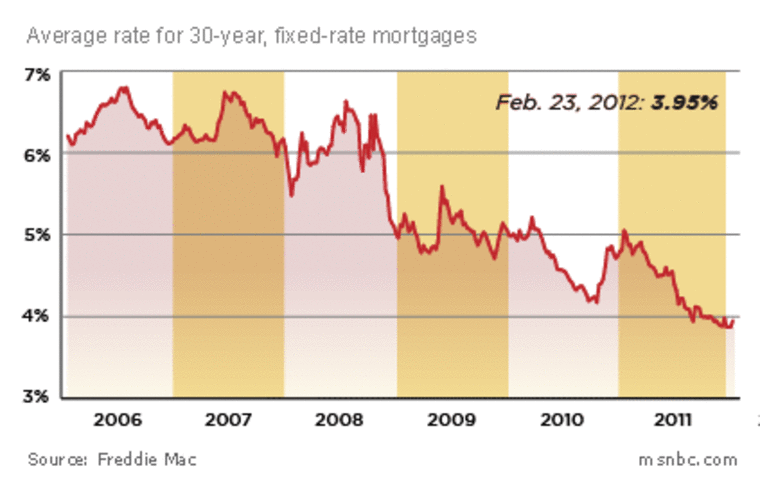Roger Wald recently discovered he would save $25,000 a year if he refinanced his five-year mortgage at 4.75 percent. Wald, an auto body repairman in Sarasota, Fla., could have gotten that rate last month.
But like many homeowners, he waited for rates to fall further. Now, he's worried he missed his chance.
Mortgage rates at some lenders spiked by as much as 1 percent on Wednesday and saw little relief on Thursday, according to mortgage brokers.
"The 4.75 percent my broker quoted two weeks ago? There's no way I'm going to get that now," said Wald, 49.
The fear dogging homeowners and investors alike is that April's record lows in mortgage rates may have come and gone.
The stock market has rallied since early March on the assumption the economy will rebound later this year. Federal Reserve Chairman Ben Bernanke has been calling early signs of economic stabilization "green shoots" — and one of those shoots was a pickup in refinancing activity caused by tumbling mortgage rates.
But mortgage rates have rebounded sharply over the past few days as the nation's growing debt raises concerns that government-backed assets could lose some of their value. It's a trend that could slow both refinancing and home buying if it continues. Higher mortgage rates won't necessarily derail the economy's recovery, analysts say, but it certainly won't help.
"If the Fed does not step in, you are going to see the 'green shoots' get frost bite," said T.J. Marta, founder of financial research firm Marta on the Markets.
The average rate for a 30-year fixed mortgage is back at 4.91 percent this week, up from 4.82 percent last week, Freddie Mac said Thursday.
The 30-year fixed mortgage rate hit a record low of 4.78 percent in April thanks in large part to the Fed's decision this year to buy as much as $1.25 trillion in mortgage securities and $300 billion in Treasury notes. So far, the Fed has bought $130.5 billion in government debt and more than $431 billion in mortgage securities.
Lower rates led to a surge in mortgage applications. Applications rose for five straight weeks between early March and early April, according to the Mortgage Bankers Association. And sales of both existing and new homes ticked higher from March to April, according to data released this week.
The Fed's moves, however, have recently lost their effectiveness in the market. The yields on the 10-year and 30-year Treasury notes have surged to a six-month high, and are nearly where they were a year ago. That's significant because Treasury yields, or their annual rates of return, help set mortgage rates.
Mortgage activity is already starting to decline. Mortgage applications tumbled 14 percent in the week ended May 22 from the previous week, the Mortgage Bankers Association said Wednesday. Applications to refinance a loan were down almost 19 percent.
The Fed has many tools to bring rates down again. It could increase how much it intends to spend on Treasury purchases or mortgage-backed securities. It could also decide to simply buy longer-dated Treasurys, said David Ader, government bond strategist at RBS Greenwich Capital. Recently, the Fed has been focusing on buying shorter-term government debt.
But if the Fed buys more Treasurys, some investors worry the central bank's moves could have unintended consequences. That's because when the Fed buys the debt that the government issues, it is essentially creating money. And that can cause inflation and weaken the value of the dollar against other major currencies.
A plunge in the dollar and high inflation might scare away foreign investors from buying U.S. debt, said Mike Larson, a real estate analyst with Weiss Research. And that would cause Treasury yields to rise eventually anyway, he said.
"The Fed is really backed into a corner," Larson said.
It would be preferable if the 10-year Treasury yield fell back to 3 percent, from its current 3.75, said Mark Zandi, chief economist at Moody's Economy.com. Such a pullback would help bring down mortgage rates and motivate people to refinance and buy homes.
When borrowers refinance to lower rates their monthly payments goes down so they have more free cash to spend on other things they need and want. And that's good for businesses — consumer spending in accounts for about two-thirds of economic activity.
Dan Lawrence, Wald's mortgage broker in Florida, said clients of his who have refinanced to a lower rate averaged between $300 and $400 in savings on their monthly mortgage payments, and almost assuredly pump some of those savings back into the economy.
"They're going to go out dinner more. They're going to buy shoes," he said.
But many analysts, including Larson at Weiss Research, expect mortgage rates to head back toward 6 percent. The question, they say, is how fast.
